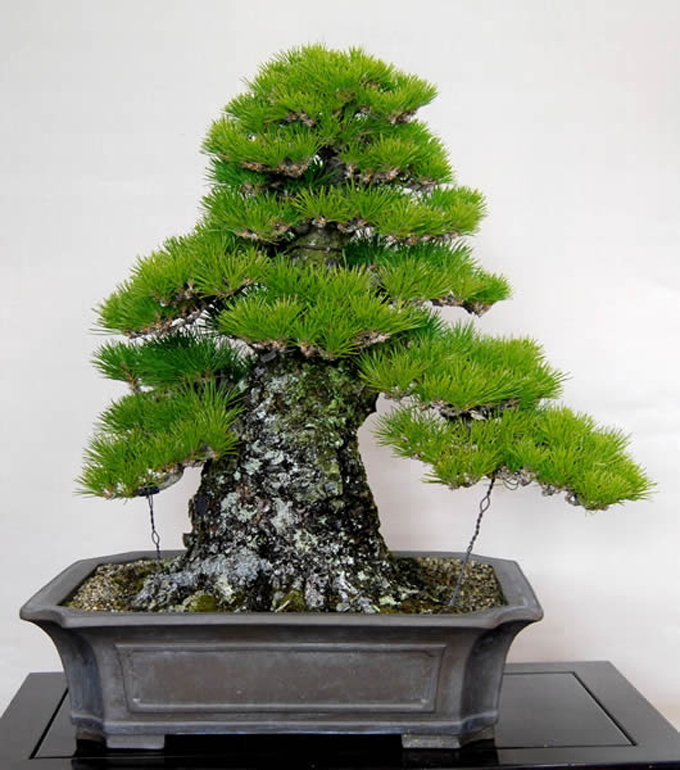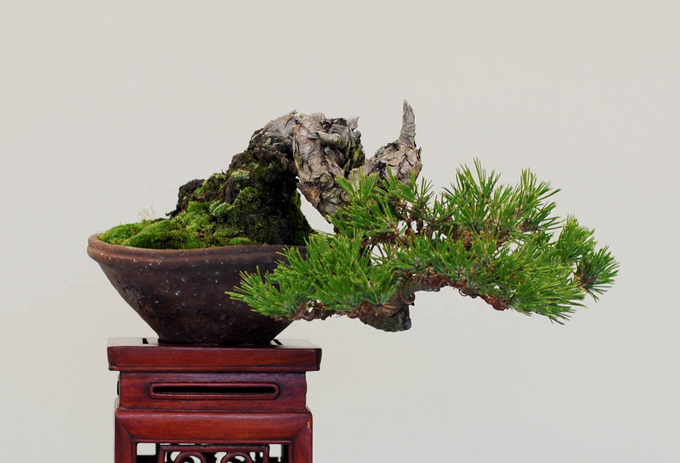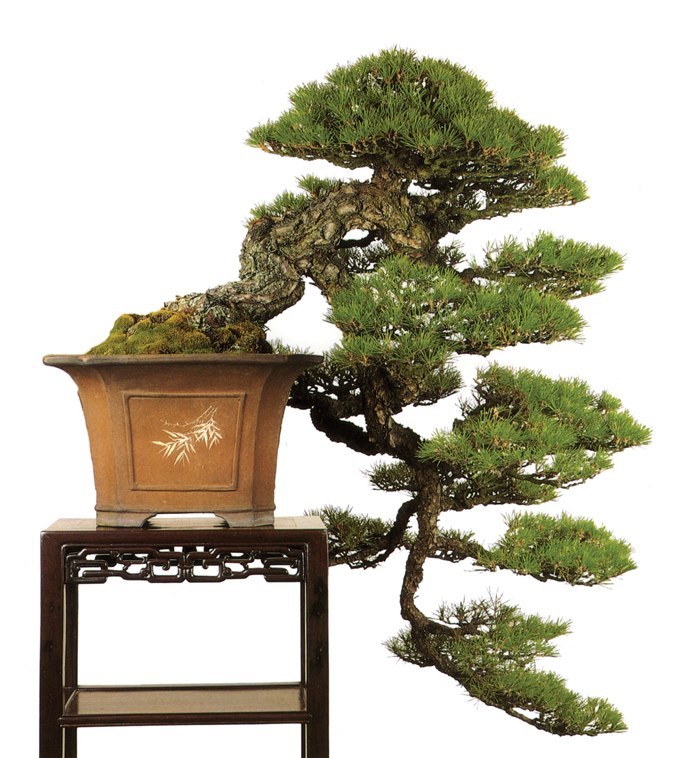 This trunk is so heavy that you could imagine it supporting a huge mass of foliage, yet this humble crown works to perfection. There’s a lot more that could be said about this great old tree, but I’ll stop at pointing out the luminous color and texture of the trunk (not that you could miss it). The tree is around 50-years-old and was grown from seed. It belongs to Kiyoshi Hiramatsu (great name for someone who grows pines) owner of the Hiramatsu Seijuen bonsai garden in Takamatsu’s Kokubunji area in Japan.
This trunk is so heavy that you could imagine it supporting a huge mass of foliage, yet this humble crown works to perfection. There’s a lot more that could be said about this great old tree, but I’ll stop at pointing out the luminous color and texture of the trunk (not that you could miss it). The tree is around 50-years-old and was grown from seed. It belongs to Kiyoshi Hiramatsu (great name for someone who grows pines) owner of the Hiramatsu Seijuen bonsai garden in Takamatsu’s Kokubunji area in Japan.
We just ended 2013 with three great Kuromatsu (Japanese black pines), so let’s start the new year on the same note.
 Semi Cascade Shohin Japanese black pine from the Bay Island Bonsai’s 11th annual exhibit in Pleasanton, California. The photo is by Jonah Dupuich, Bonsai Tonight. Normally, cascading bonsai are shot with the cascade to the right or left. No problem though, this angle and the fact that’ the shot is so close-up, allows you to appreciate the bark and the quality of the needle reduction. Not to mention a different take on the tree’s movement and the unique pot.
Semi Cascade Shohin Japanese black pine from the Bay Island Bonsai’s 11th annual exhibit in Pleasanton, California. The photo is by Jonah Dupuich, Bonsai Tonight. Normally, cascading bonsai are shot with the cascade to the right or left. No problem though, this angle and the fact that’ the shot is so close-up, allows you to appreciate the bark and the quality of the needle reduction. Not to mention a different take on the tree’s movement and the unique pot.
 From Worlds Within Worlds 2: Black Pines, an article on Andy Rutledge’s Bonsai Journal. Here’s Andy’s caption: “This pine is a good example of the important traits of a good black pine bonsai; powerful trunk, aged bark, strong rootage, strong and dark green foliage. Notice how compact the growth is.” Photo by Boon Manakitivipart.
From Worlds Within Worlds 2: Black Pines, an article on Andy Rutledge’s Bonsai Journal. Here’s Andy’s caption: “This pine is a good example of the important traits of a good black pine bonsai; powerful trunk, aged bark, strong rootage, strong and dark green foliage. Notice how compact the growth is.” Photo by Boon Manakitivipart.
 This remarkable and famous cascade Japanese black pine is from the gallery section in our also famous Pine book.
This remarkable and famous cascade Japanese black pine is from the gallery section in our also famous Pine book.
The Shohin semicascade is a tree that I purchased about six years ago from Don Blackmond at Gregory Beach Bonsai. It was approaching Kifu size it was redesigned prior to the BIB Show by Daisaku Nomotu, Boon’s Senior at Kihachi-en in Japan. The pot it is pictured in is from Bunzan, it currently resides in a mid centuryYamaaki pot.
Thanks John,
Great tree. Send a current photo if you get a chance.
Wayne,
These are some beautiful examples of black pines, but i beg to differ on the first one with the massive trunk. I think the scale of this trunk is truly out of proportion with the foliage. In fact, I find that many bonsai with squat, massive trunks (which you see in great abundance at some of the Japanese nurseries) just don’t work much of the time, at least for me. I much prefer to see the elegance that comes with a tree that has nebari, trunk, branching and foliage in better balance.
Thanks Tom,
Yeah, it is certainly one of many possibilities. I do have a bit of a bias towards short powerful trunks. When well done of course (according to my idea of well done at least). But then I have a bias towards tall elegant styles too.
But I do see your point about many of the short heavy bonsai you see in Japan. However, I do like this tree. To my eyes it is powerful and radiant.
Thanks for posting these elegant photo examples of mature bonsai. My middle school bonsai students enjoy searching the Bonsai Bark at each meeting and usually add a photo or two to their “digital bonsai scrapbooks.” I’m sure they dream of having a bonsai like these someday.
Thanks Jean,
That’s excellent. It’s always good to hear that someone out there loves us.
This is both a massive trunk and an immature tree. It will be fun to see this tree in 20 years or so, when the trunk and branches are in some level of scale.
Wayne,
The last pine lives in Taipei, Taiwan and is part of the collection of Mr. Xiu Zuo Li.
Warm regards,
Jose Luis
Hi John,
Agreed. The trunk is ahead of the rest of the tree. But what a great trunk it is.